Here is teardown of another cheap USB charger bought some time ago for around two euros from some chinese online shop. Brand “Designed by Able” Model 1300.
Label
Circuit board
Closeup of circuit board
One finding is that rectifier is replaced with diode, meaning that this half-wave rectifies mains power.
Other findings:
- The switcher circuit is based on two transistors (SW 13003 and UTC S8030) and optiosolator feedback
- There does not seem to be any fuse (or fusible resistor or other protection component) anywhere, the mains power is directly rectified with 1N4007 diode to main capactor
- The insulation distances between promary and secondary on the circuit board are quite small: shortest distance around 3 mm from solder to solder and slightly over 2 mm track-to-track
I don’t don’t thinks this is safe or good quality power supply. It might not be immediately dangerous, but the safely level is very low -I quess that this might not get though all the electrical safety regulations if gets tested by regulators.
If you need USB power supply, get something safer.
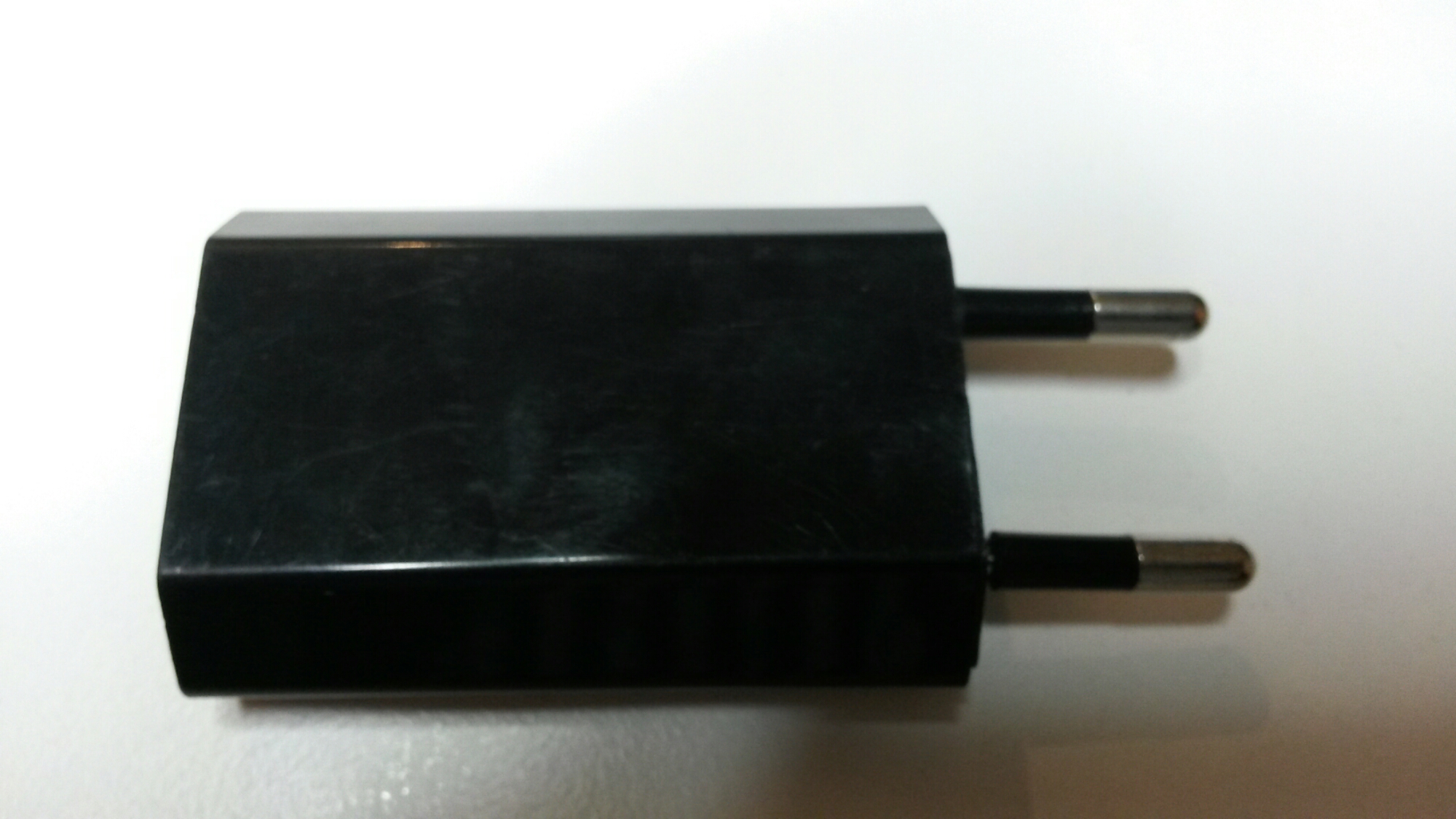
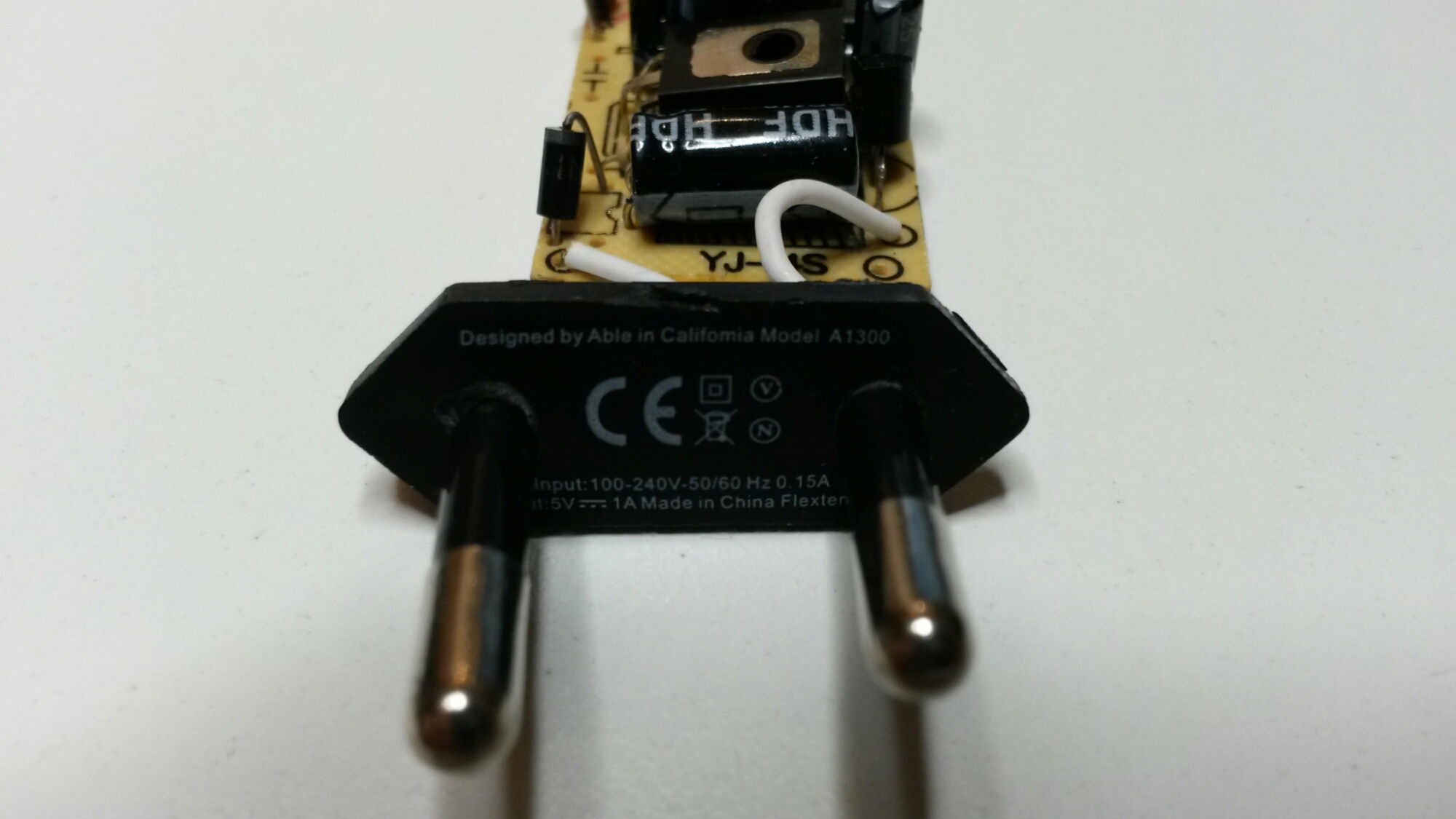
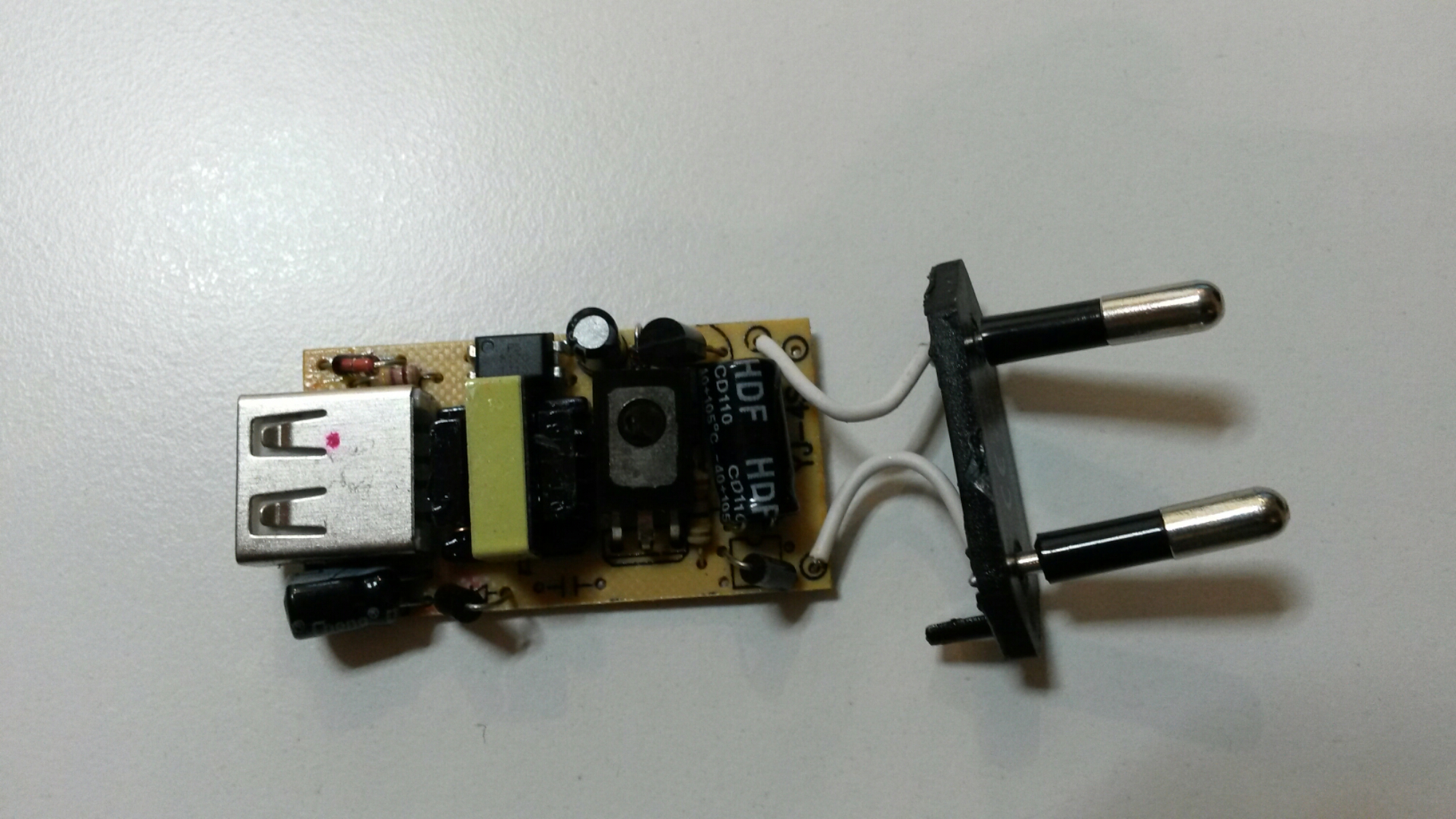
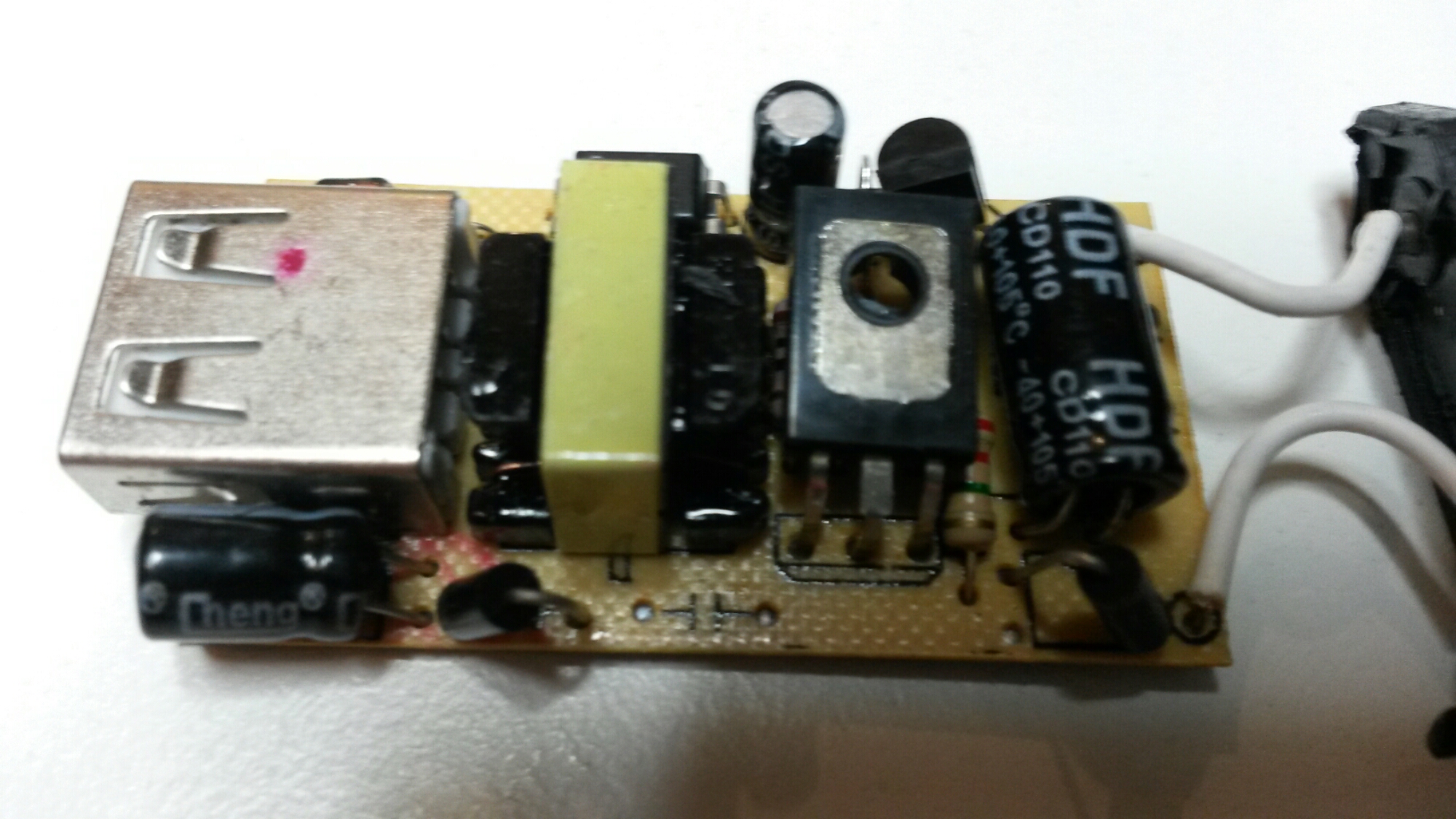
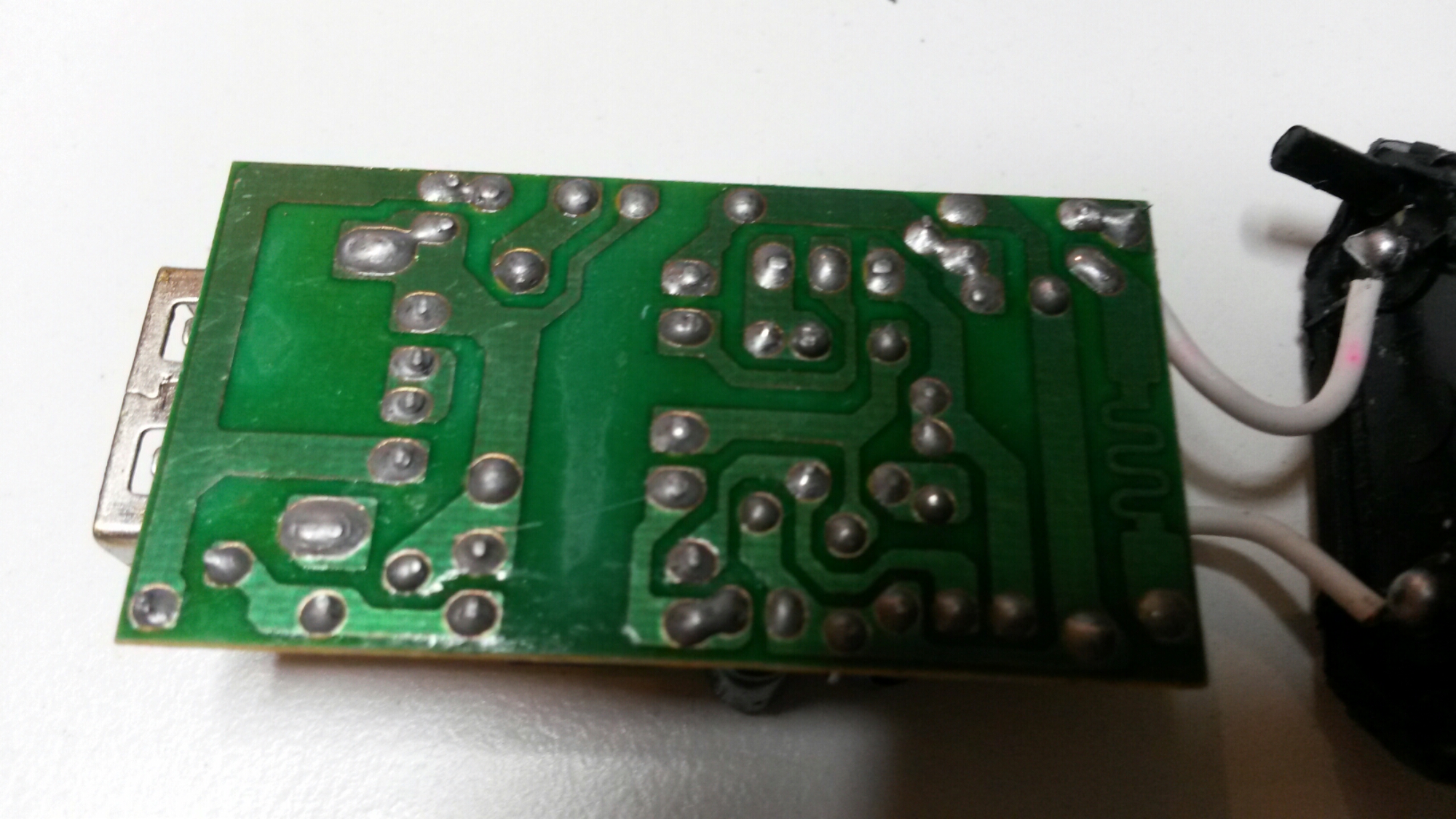
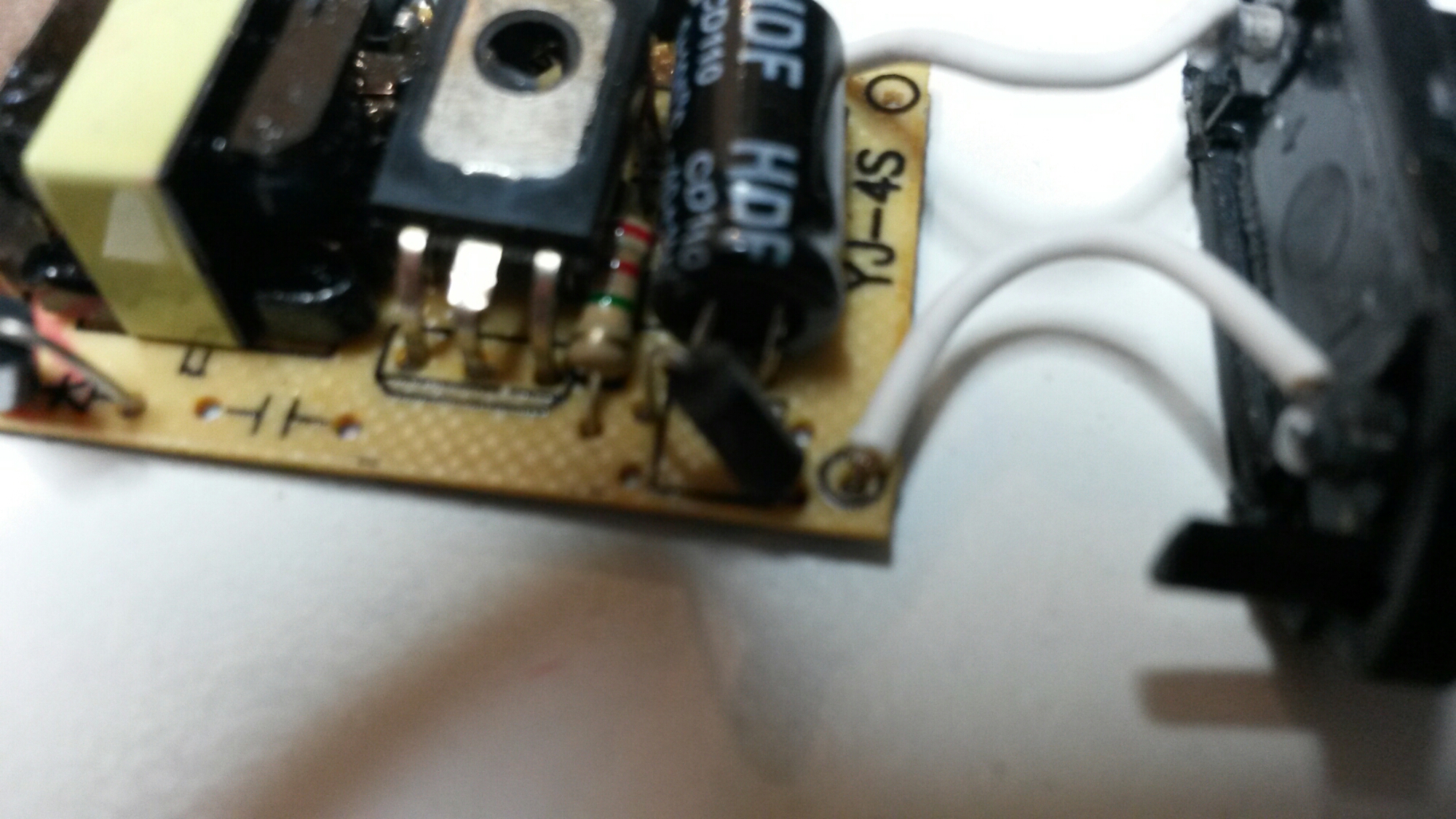
64 Comments
Tomi Engdahl says:
On the right side of the circuit board (when looking the copped side) there seems to be some very thin traces that look a little bit that they could be designed as fuse in circuit board. Maybe there was idea that this would be fuse, and maybe would have worked as such if original bridge rectifier would have been put to circuit board. But the board is no built so that the mains power does not go through this “circuit board fuse”.
Can thin sections of copper traces be used as fuses?
http://electronics.stackexchange.com/questions/200350/can-thin-sections-of-copper-traces-be-used-as-fuses
Is it safe to use thin sections of copper traces as one-shot fuses when cost is important, but when it is also vital to protect the rest of the circuitry? Should the solder mask be removed at that location?
It’s certainly been done.
It’s a bit more of a crapshoot than a traditional fuse, like a printed spark gap, but can be done. The trace should not be exposed. An exposed trace will be subject to contamination, possibly conductive contamination, which changes the amount of conductor you designed for a certain current. Admittedly a minor concern, but I don’t see any pros for exposing the trace.
This paper explores and provides calculations for determining trace size for a printed fuse with a variety of copper weights.
http://www.ultracad.com/articles/fusingr.pdf
A salient point from the paper, in case it isn’t always available is the approximation for the time in seconds (t) before a trace reaches melting temperature given current passing through it (I) and its cross sectional area in mils squared (A):
t=0.0346×((A^2) / I)
Note that this is the approximate time to melt the copper given a 20°C ambient temperature. It might fail long before or a short time after this value.
Tomi Engdahl says:
From:
http://www.edaboard.com/thread5720.html
IMHO pcb trace can be used as a fuse, if the requirements are not very precise. In other words, diffrence between operating current and fault current are very wide, and the purpose is primarly to prevent fire than protect some other components. For instance it mightbe good enough in a car environment, where the battery for sure delivers plenty of current in case of a short circuit, and while the load to be protected is something simple with quite predictable failure modes (short to chassis or similar).
One big trouble is that the PCB is seriously damaged when the fuse blows.
I would in most cases recommend a pcb solderable chip fuse, or other well specified “real” fuse.
Tomi Engdahl says:
99% of fake Apple chargers fail a basic safety test, new study says
http://www.businessinsider.com/apple-fake-chargers-study-2016-12?r=US&IR=T&IR=T
It should go without saying, but if you buy a spare charger for an Apple device, you should absolutely make sure it’s from a known, reputable company.
Your latest reminder of this comes from the Chartered Trading Standards Institute, a UK consumer protection organization that teamed up with Illinois-based safety testers UL to examine 400 “counterfeit Apple chargers” from various suppliers.
According to the study, all but three of the 400 counterfeit chargers failed a “basic” safety test, in which high voltages were applied to the chargers to see if they had enough isolation to protect against electric shocks.
The study comes just a few weeks after Apple reportedly conducted its own study on third-party power accessories, and found that roughly 90% of Apple chargers and cables sold through Amazon were unsafe.
Whatever the case, fake chargers are still more common than they should be today.
Getting chargers and cables directly from Apple is the easiest thing to do. Especially on the cable side, if you don’t want to pay the premium Apple often slaps on, look for accessories with Apple’s MFi (Made for iPhone/iPad/iPod) certification on its packaging.
COUNTERFEIT IPHONE ADAPTERS
A UL TECHNICAL INVESTIGATION SHOWS A 99 PERCENT FAILURE RATE
http://library.ul.com/wp-content/uploads/sites/40/2016/09/10314-CounterfeitiPhone-WP-HighRes_FINAL.pdf
Tomi Engdahl says:
Similar looking USB charger also analyzed here:
USB Power Supply/charger Test
http://www.lygte-info.dk/info/usbPowerSupplyTest%20UK.html
Tomi Engdahl says:
There has been several USB chargers that were removed from market as as dangerous products:
http://etn.fi/index.php?option=com_content&view=article&id=5626:tukes-kielsi-viiden-usb-laturin-myynnin&catid=13&Itemid=101
http://marek.tukes.fi/
Tomi Engdahl says:
Do not use these: The authorities in Finland tested UBS chargers – half revealed dangerous
Randomly selected 10 of the device, only one passed the test Tukes clean slate.
Finnish Safety and Chemicals Agency (Tukes) says in a statement of tested 10 online shops sold charger and have found significant shortcomings.
sale five-charger banned altogether. Shortcomings related to the insulation of the equipment and caused an electric shock hazard.
Four charger got the note labels or inadequate instructions for use. Only one charger got a clean bill of health.
Source: http://www.iltasanomat.fi/digitoday/art-2000005015797.html?ref=rss
Tomi Engdahl says:
Inside some dodgy Chinese USB power supplies from Greece.
https://www.youtube.com/watch?v=bNoGCdX1IdQ
VERY shady USB chargers which he bought from a Chinese outlet in Greece.
The flat one has one of the scariest transformers yet with no extra insulation between the secondary and sense windings. It also had a rather odd output capability of around just 20mA before the voltage plummeted.
Tomi Engdahl says:
Cheap $8 Ebay Power Supply vs $85 Cosel Power Supply Teardown
https://www.youtube.com/watch?v=71NWT5vrbk8
A teardown and comparison between a cheap $8 made-in-China power supply and a $85 Cosel power supply (50W, 24V).
Tomi Engdahl says:
A dozen USB chargers in the lab: Apple is very good, but not quite the best
http://www.righto.com/2012/10/a-dozen-usb-chargers-in-lab-apple-is.html
Conclusions
So what charger should you spend your hard-earned money on? First, make sure the charger will work with your phone – for instance, newer iPhones only work with certain chargers. Second, don’t buy a counterfeit charger; the price is great, but it’s not worth risking your expensive device or your safety. Beyond that, it’s your decision on how much quality is worth versus price, and I hope the data here helps you make a decision
Tomi Engdahl says:
Deadly USB Charger (Fake Apple) + Explosions
https://www.youtube.com/watch?v=nMmySM2nar8
A deadly dangerous USB charger (fake Apple iPhone charger) from China. Sold on Ebay for 90 cents including shipping. The PCB board has only 1mm distance between primary and secondary side. The EMI capacitor between primary and secondary side is only rated 1kV (should be Y1 class with a test voltage of 8kV). The transformer isolation is also questionable. The power supply has no fuse (just mains-bridge-electrolyte!). This poses serious risk of fire. When the power transistor shorts out (and it is likely to do so, because there’s no snubber network), the primary of the switching transistor gets essentially connected to mains with no fusing. This is likely to cause a meltdown of the transformer and get mains to the output.
Tomi Engdahl says:
Inside some dodgy Chinese USB power supplies from Greece.
https://www.youtube.com/watch?v=bNoGCdX1IdQ
The flat one has one of the scariest transformers yet with no extra insulation between the secondary and sense windings. It also had a rather odd output capability of around just 20mA before the voltage plummeted.
Tomi Engdahl says:
Autopsy of an exploded USB power supply. (With skidmark)
https://www.youtube.com/watch?v=u8gPBehklkU
Thanks to Gerard for sending in this pre-detonated multi-port USB power supply.
Given the isolation between the mains voltage primary windings and the low voltage secondary windings, perhaps it’s a good thing that it exploded.
It’s a shame, because the transformer is the only bit that really lets it down. The circuitry looks like a textbook switchmode based around a dedicated chip.
The reason for the failure is not clear, but a short has occurred that has made a track on the output of the rectifier blow like a fuse and cause a more serious short by virtue of the metal laden plasma.
The glass fuse has blown in half s they are not really suited to breaking high current faults.
Tomi Engdahl says:
Teardown of a cheap UK style USB power supply.
https://www.youtube.com/watch?v=bmtW_oA1fRo
little USB PSU from Banggood for a measly $2 purely to examine its circuitry and internal electrical isolation. I thought it was going to be a bit more crowded inside than it is, but was very surprised to see that it uses a single sided board with standard through-hole components, but still manages to provide a tolerable level of electrical separation on the PCB.
The transformer itself could potentially just have a layer of tape between the primary and secondary windings, and the capacitor used between the primary and secondary could also pose a shock hazard if it failed.
But aside from these potential weak points the unit is quite intriguingly simple. It doesn’t use any non-standard components other than the custom would transformer and that includes common TO92 NPN transistors.
Tomi Engdahl says:
Inside a well built charger:
Samsung USB Charger Failure and Repair
https://www.youtube.com/watch?v=9xpHsnY8oc0
In this video I’m examining and repairing my faulty USB phone charger (5V 1A switching power supply). It failed after 2 years of seldom use. I’ve drawn a partial schematic in the video. Full reverse engineered schematic of this charger is here:
http://danyk.cz/reverz33_en.html
Tomi Engdahl says:
Test of the Yihua 502D USB bench power supply. (With fix!)
https://www.youtube.com/watch?v=rz-ndgC6BJ4
Tomi Engdahl says:
Dangerous Chinese Travel Extension with USB Charger – teardown
https://www.youtube.com/watch?v=tOzjjWAVBrU
The charger can’t continuously supply the claimed 4.8A current and the mains isolation is questionable. Risk of electric shock and fire.
Tomi Engdahl says:
https://tukes.fi/artikkeli/-/asset_publisher/tukes-testautti-halpisverkkokauppojen-tuotteita-lahes-kaikki-lelut-lastentarvikkeet-ja-sahkolaitteet-vaarallisia
Tomi Engdahl says:
Kun tilaat laturin EU:n ulkopuolelta – omalla vastuulla
https://www.youtube.com/watch?v=TYm2M3bpnVg
Tomi Engdahl says:
Deadly 3-USB Charger (test, teardown, schematic, oscilloscope measurements)
https://www.youtube.com/watch?v=OHf1U8etd6M
Chinese 5V 1A USB charger with 3 USB ports
This power supply from China from Ebay turned out to be a death trap. It’s dangerous because of a too narrow isolation on the board and virtually no isolation in the transformer. The USB output and thus your phone or other device may easily become live at mains voltage, leading to an electric shock. Having no fuse, it also poses a fire hazard.
Tomi Engdahl says:
Deadly USB Charger (Fake Apple) + Explosions
https://www.youtube.com/watch?v=nMmySM2nar8
A deadly dangerous USB charger (fake Apple iPhone charger) from China. Sold on Ebay for 90 cents including shipping. The PCB board has only 1mm distance between primary and secondary side. The EMI capacitor between primary and secondary side is only rated 1kV (should be Y1 class with a test voltage of 8kV). The transformer isolation is also questionable. The power supply has no fuse (just mains-bridge-electrolyte!). This poses serious risk of fire. When the power transistor shorts out (and it is likely to do so, because there’s no snubber network), the primary of the switching transistor gets essentially connected to mains with no fusing. This is likely to cause a meltdown of the transformer and get mains to the output. An explosive test has demonstrated this :).
Tomi Engdahl says:
Look inside what is in a little bit better constructed USB charger (not immediately dangerous):
Samsung USB Charger Failure and Repair
https://www.youtube.com/watch?v=9xpHsnY8oc0
In this video I’m examining and repairing my faulty USB phone charger (5V 1A switching power supply). It failed after 2 years of seldom use.
Tomi Engdahl says:
DANGEROUS Chinese USB charger (no isolation in the transformer!)
https://www.youtube.com/watch?v=ehYYoU13i-I
Then I found that the transformer in it has no isolation between the windings! This USB charger from China (fake Apple iPhone charger) has a transformer with no insulation tape between the primary and secondary side. The output of it (and thus the entire phone including its metal casing) is isolated from mains just by a super thin layer of enamel (lacquer) on the magnet wire! This means a very high risk of an electric shock and death. This dangerous electrocution device comes in various colors including white, which looks just like a real Apple iPhone charger.
Tomi Engdahl says:
Inside some dodgy Chinese USB power supplies from Greece.
https://www.youtube.com/watch?v=bNoGCdX1IdQ
bought from a Chinese outlet in Greece. The flat one has one of the scariest transformers yet with no extra insulation between the secondary and sense windings. It also had a rather odd output capability of around just 20mA before the voltage plummeted.
Tomi Engdahl says:
USB Sockets and the Issues Testing for Insulation Resistance (USB Socket)
https://www.youtube.com/watch?v=9Ty93r5yxUs
Students training aid for testing insulation resistance. Demonstration shows how an insulation resistance test could damage a USB socket outlet and how to overcome this. Test voltage is 500V d.c. and the minimum acceptable value according to BS 7671 is 1 megohms for the whole installation with further investigation when the reading falls below 2 megohms.
Note a 3 lead low earth fault loop impedance test will pickup if you have forgotten to reconnect either the line(s) or neutral(s) of the UBS socket outlet.
Comments:
I wish the USB components were switched – cannot be beyond the wit of man to design and fit into that ‘generous’ bit of real estate that is the standard twin 13A socket. I fitted a rise and fall power strip (with USB sockets) to a kitchen island that is switched – very happy with that.
Another excellent video. As a non-professional, I can’t help but wonder if industry should come up with a design solution to enable a full voltage test?
Yay, same tester as mine! Very useful video. More and more inline electronics are slowly but surely being introduced into modern installations. Watch out for smart home technology, soon we’ll all be spending lengthy periods testing. Informative stuff.
Tomi Engdahl says:
Lethal fake Nokia charger takes the plunge
https://www.youtube.com/watch?v=KFb0vz5br70
I don’t think you’re supposed to have a spark gap between primary and secondary. Oh well, blub blub blub.
That thing is just unbelievably awful.
Tomi Engdahl says:
Deadly USB Charger (Fake Apple) + Explosions
https://www.youtube.com/watch?v=nMmySM2nar8
A deadly dangerous USB charger (fake Apple iPhone charger) from China. Sold on Ebay for 90 cents including shipping. The PCB board has only 1mm distance between primary and secondary side. The EMI capacitor between primary and secondary side is only rated 1kV (should be Y1 class with a test voltage of 8kV). The transformer isolation is also questionable. The power supply has no fuse (just mains-bridge-electrolyte!). This poses serious risk of fire. When the power transistor shorts out (and it is likely to do so, because there’s no snubber network), the primary of the switching transistor gets essentially connected to mains with no fusing. This is likely to cause a meltdown of the transformer and get mains to the output. An explosive test has demonstrated this
Tomi Engdahl says:
EEVblog #388 – Fake Apple USB Charger Teardown
https://www.youtube.com/watch?v=wi-b9k-0KfE
What is inside a fake clone A1265 Apple USB charger?
WARNING: These fakes and cheap no-name chargers are DANGEROUS. If you have one, throw it out and get a quality one.
Apple iPod chargers – fake versus genuine
https://www.youtube.com/watch?v=_exfmbsPqEI
I bought a genuine Apple charger off eBay. The seller kindly threw in a second charger, however that one wasn’t quite so genuine…
Tomi Engdahl says:
Fake Nokia charger destruct-a-teardown II
https://www.youtube.com/watch?v=KL7TVy3Hnnc
Pop goes the Chinese fake.
This “Nokia” charger is not as dangerous as the last one
, but its discrete oscillator design, lack of any RF suppression, and barely regulated 6-volt output doesn’t make for a very impressive device.
It also caught fire.
Lethal fake Nokia charger takes the plunge
https://www.youtube.com/watch?v=KFb0vz5br70
I don’t think you’re supposed to have a spark gap between primary and secondary. Oh well, blub blub blub.
Tomi Engdahl says:
Let’s [Quickly] Open: ORICO 20W 4-port USB Charger + Teardown
https://www.youtube.com/watch?v=FgbRxdpqJaA
I had been looking for a cheap and cheerful USB power supply for general charging of phones, tablets, and plenty of etcetera. Hence I ordered this ORICO 4-Port USB Charger with high hopes!
Tomi Engdahl says:
NEWNOW 6 usb ports 30W charger review and teardown
https://www.youtube.com/watch?v=LuvlWRS0c4Q
Bargain bought for £1.56 on ebay. Quick look at the insides, surprisingly good design. 2 minor issues discovered and fixed. Fantastic charger which will free up many sockets on my desk. Highly recommended if you need multiple charge points.
Tomi Engdahl says:
The supergayrainbow explosion. Which colour went bang?
https://www.youtube.com/watch?v=hBWUBom7u-0
No more bets please ladies and gentlemen. The table is now closed. Lets spin the wheel of misfortune and see which of these lurid power supplies pops it’s little lid with a bang.
Tomi Engdahl says:
Teardown of an IKEA Koppla USB power supply.
https://www.youtube.com/watch?v=uRe9w5PKmsE
I’ve always recommended using prominent brand USB chargers for safety. So I thought I’d take an IKEA one to bits and assess it for safety with regards to isolation and transformer construction.
Comments:
As a Swedish licenced electrician, I can tell you that almost every electrical appliance that comes packaged in Sweden is made so it’s hard to open.
There is a certain safety standard in Sweden that people have gotten used to, and very few people ever open their electronics themselves. Although it is legal to switch plugs or lamp sockets if you know how to, most people would even call an electrician to do that for them.
IKEA makes a big point about being even safer than the safety standards, so it’s no surprise that the thing was hard to get into.
Tomi Engdahl says:
Inside some dodgy Chinese USB power supplies from Greece.
https://www.youtube.com/watch?v=bNoGCdX1IdQ
Tomi Engdahl says:
Questionable 2-in-1 USB charger – test, schematic & modifications
https://www.youtube.com/watch?v=D4RqBEBt7MY
I thoroughly test and examine a cheap two in one 5V USB charger with a 100-240Vac mains input and a 12-24Vdc car input. I take a look inside, reverse engineer its schematic and explain how does it work. Then I try to do a lot of modifications to the circuit. Surprisingly, this doesn’t go horribly wrong, just horribly long :).
Tomi Engdahl says:
Dangerous USB phone chargers
https://www.youtube.com/watch?v=tIaHg6M_y7w
let’s examine some USB chargers. Most of them are generic (read: fake). Such chargers may be quite dodgy. They can cause a fire or an electric shock and electrocution death. But there are also some good ones.
Tomi Engdahl says:
How to test mobile charger – Dangerous USB phone charger – Mobile charger repair
https://m.youtube.com/watch?v=XDyCz4WIawg&feature=youtu.be
Hello! When mobile charger comes AC voltage, what do you do? In this video I have shown how to turn off the AC voltage flow through a DC charger. It will not shock anyone but it can be very dangerous for other charger. ( Everyone should check own mobile charger).
Tomi Engdahl says:
Poundland USB versus lightning (The lightning won.)
https://www.youtube.com/watch?v=12tqhkphNps
A look at the exploded remnants of a Poundland USB charger that clearly didn’t enjoy a lightning induced voltage spike between live and neutral.
It’s not uncommon for small electronic power supplies to explode when they fail in UK sockets, as they rarely have the protection required to safely break the current available from the power circuit.
I’m going to have to get another of this type of power supply as it’s clear it has been redesigned since I took one apart. The early ones had an issue with the output rectifier diode getting too hot and failing when the supply was being run at maximum current.
Tomi Engdahl says:
Dangerous USB phone chargers 4
https://www.youtube.com/watch?v=dguBEoU6OQ8
Another collection of dodgy USB phone chargers from eBay that may cause an electric shock or fire. They also tend to have a poor interference suppression, poor output voltage regulation and a fake current rating.
Tomi Engdahl says:
Single Transistor Mobile Phone Charger
https://www.electrothinks.com/2020/06/Single-transistor-mobile-phone-charger.html
The Single transistor mobile phone charger is known for its size, price, and easy usage.
These cheap mobile charger use only a few parts, a very simple SMPS design.
But there’s a drawback too, they got damaged easily.
Tomi Engdahl says:
Dangerous USB phone chargers 5 (Quick 18W QC 3.0)
https://www.youtube.com/watch?v=z7rwc95neNg
Another collection of dodgy USB phone chargers from eBay. This time a quick charger edition. Three cheap USB chargers that support 18W QC3.0 charging and they can supply 5V 3A, 9V 2A or 12V 1.5A. Some of those cheap chargers may not comply with safety regulations and they may cause an electric shock or fire. They also tend to have a non-existent interference suppression, poor output voltage regulation and a fake current rating.
Tomi Engdahl says:
https://www.google.com/search?q=big+clive+usb+charger
Tomi Engdahl says:
Dangerous USB phone chargers 7 (QC 3.0)
https://www.youtube.com/watch?v=-FIo7eMI0hU
Yet another collection of 2 dodgy quick QC3.0 USB phone chargers from eBay, probably fake Qualcomm. Some questionable chargers may not comply with safety regulations and they may cause an electric shock or fire. Their current rating may be fake and they can damage your devices.
Tomi Engdahl says:
Dodgy chargers never get boring
Tomi Engdahl says:
Dangerous USB phone chargers 6 (Quick QC 3.0)
https://www.youtube.com/watch?v=nf4kv3MHTgI
Tomi Engdahl says:
Dangerous USB phone chargers 8
https://www.youtube.com/watch?v=yyNzA4Upip8
There’s never enough of dodgy USB phone chargers. Let test another 2 pieces and let’s see what’s inside. Some questionable chargers may not comply with safety regulations and they may cause an electric shock or fire. Their current rating may be fake and they can damage your devices.
Tomi Engdahl says:
Aulola TH19 USB power supply teardown
https://www.youtube.com/watch?v=Szywk1S0vlY
a cheap Aulola TH19 USB power supply instead of the original. I had no intention of using it (especially after seeing some of the Amazon reviews) so thought I’d rip it to bits for your viewing pleasure.
INDEX
0:00 Index
0:10 Introduction: Aulola TH19 USB power supply
0:57 Those Amazon photos don’t look promising!
1:16 Load testing to 100% and beyond
2:20 What’s inside?
3:43 Schematic
5:23 Conclusions
Schematic can be found at
https://www.facebook.com/AintBigAintClever/photos/p.2881689598809384/2881689598809384/
Tomi Engdahl says:
Finally a safe USB charger?
https://www.youtube.com/watch?v=qRzuhWZoHXU
What’s inside a genuine Lenovo USB phone charger and how does it differ from cheap fake dangerous chargers. A teardown to explore the safety and quality factor, including the autopsy of the transformer. How much effort did they do to prevent an electric shock?
Viewer comments:
“So the conclusion is… NICE :).”
That’s exactly what we want to see – properly built chargers designed to last a long time, work properly and work safely without putting you (or your devices) at risk.
Sadly a lot of cheap chargers tend to miss some safety critical steps, as seen in the “dangerous USB chargers” series.
By the way, the yellow insulated wire is called “Triple Insulated Wire” or “TIW” for short, in case you didnt know. Popular manufacturers are Furukawa and Totoku.
Well, how amazing! Who would have thought that wire with three layers of insulation would be called “triple insulated wire”?
By the way, in my house I have wire with two layers of insulation, and that is called “Double Insulated Wire”…. go figure!
Old Design, but very well made, they went all out on the transformer.
the key with the insulation on the transformer winding isn’t just the thickness or dielectric strength, its about physical resistance to abrasion and flexing. the lacquer on transformer wire will actually insulate several hundred volts perfectly well, but its very easy to nick or abrade a flaw into it, and thats especially relevant in these tiny transformers which are wound in huge numbers at great speed. a layer of pvc or similar insulation is so much tougher and more durable.
This is so different from the previous ones!
I was in serious distrust of power adaptors, but now I know that not all adptors are intended to set your bedside on fire. Thanks for the video.
Now I am feeling sad.
It looks that it was the last well made charger in the world and you destroyed it
This is the first charger i think passing the all test of diode gone wild.
I have similar type of usb charger from old lenovo phone (similar package but 2amp insted if 1)and im using it more than 5 years it still works nicely. Also seeing its internals is nice it is an good, safe and reliable charger.
I wonder what the actual difference in BOM and manufacturing costs is between DODGY and NICE. It cant be that much, the fundamental design and 90% of components are the same. A lot of the DODGY chargers come sooo close to being a decent product, if only they’d cost-cut just a tiny bit less.
some plastic sleeving on the secondary winding costs almost nothing. The manufacturers of cheap chargers just can’t be bothered.
I was just saying the same thing about Chinese crimping tools: they’re so close, but cut too many corners. If they targeted, say, $30-40 instead of $15, they’d be able to make a product that actually competes with the $400 original tools, but noooo, they just go for the absolute cheapest…
Last week I opened a 6 year old Xiaomi 5V 1A charger, and it was very similar to this one. I didn’t open the transformer though
But I wonder how the regulation works without feedback. Can chip sense secondary current via transformer, because it shuts down after 1A.
If you get rid of that cap between the primary and secondary side, does that mean that the tingle you get when you touch the output also goes away? I remember seeing that the tingle is due to this cap between pri/sec. Keen to have this cleared up though!
2Years ago i made a video about the original
Samsung there is a big difference between the original charger and the imitation one
They are cutting corners all over the place
I wonder why there has to be a huge distance between the primary and secondary side of the board. The components are intact by solder and they can’t touch each other.
I cannot tell if you are serious or joking…..but if serious, you should explore “circuit separation”. It is because of “tracking” that a “creepage” gap (8mm recommended) is required between primary and secondary circuits.
But the negative side of insulation is that, it will reduce the coupling between primary and secondary and in turn will increase the leakage inductance. This will in turn need better clamp circuit reducing efficiency.
I have also opened a Lenovo charger before, same board, same transformer, but different model. The reason I opened it is it failed. Removing the parts are challenging as they are securely soldered. Well, Lenovo did a good job in manufacturing, although I can’t figure out why the charger failed. I just salvaged the components.
I have some chargers from Aliexpress, like Baseus. Touching lightning (iPhone) charger cable tip gives a slight tingle, not shock, but unpleasant. Is it something like residual current that’s not filtered out or could it be something possibly dangerous?
Probably the capacitive current throught the Y1 capacitor.
I received a no brand PD charger today, for my usb soldering iron (miniware ts80p). Touching the iron handle gives a burning tingle. Checked the gndiron body with Fluke, DC voltage 0.5V, AC 25-30V. Man, now I’m afraid to open and see what kind of horror is inside that charger.
Tomi Engdahl says:
Y Capacitor, current leakage & Electromagnetic Interference (EMI) problem.
https://www.eevblog.com/forum/beginners/y-capacitor-current-leakage-electromagnetic-interference-(emi)-problem/
Add a ground pin and connect the negative side of the power supply to GND.
This safely shorts the ground leakage current, and provides a return path for the RF noise besides. (Some more Y caps from AC line/neutral to GND may also be necessary for reduced radio interference.)
Direct connection between ground and earth (PE – protective earth) constitutes a PELV-type system: usually it’s the most common practice for class I equipment (that is, with protective earth), for example IT stuff, audio/video equipment, etc. Just to give you an example, in lighting appliances (at least in Europe) it’s not allowed, and only SELV systems are allowed (>1MOhm insulation resistance @ 500V between ground and PE).
One of the potential dangers of PELV systems is that if you have an earth fault, with huge currents flowing into the PE building conductors, it is allowed for the PE terminals to “shift” from the “real” earth up to 50V. This additional potential can “shift up” all potentials attached to it: if you have a 24V PELV system for example, it is safe to touch since it’s less than 60V. But if you have an earth fault, some points in the 24V PELV system can reach to 74V which by some safety standards is not safe anymore to touch!
Tomi Engdahl says:
What is the role of the Y capacitor in the charger?
https://www.szsoy.com/news/What-is-the-role-of-the-Y-capacitor-in-the-charger%3F-175.html
Tomi Engdahl says:
Super Simple Power Supply & Transformer Autopsy
https://www.youtube.com/watch?v=iAYDhtkozd8
Another Chinese USB charger / power supply. Rated 5V 500mA. This one has probably the simplest possible schematic. Just a single transistor, no optocoupler, half wave rectifier, no interference filter at all. The isolation distance on the board is 2.5mm, this is above Chinese average, but still could be better. The transformer is dodgy, it has just 1 – 2 layers of sticky tape between windings. The sticky tape is a bit drifted to the side, so the first / last turn of secondary can possibly meet the primary. There’s no fuse, just a chinese “onboard fuse”. No inrush limiter. The output diode is 1N4148 rated 150mA, despite the supply is rated 500mA. It has different USB output configuration compared to other supplies. One data pin is connected to GND and the other one is not connected to anything.